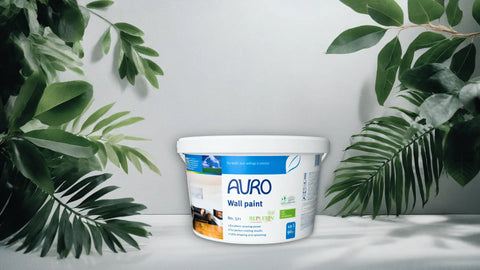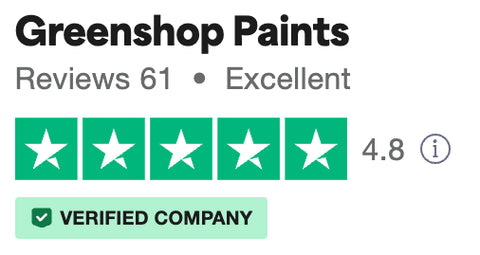Lime plaster is a beautiful, breathable finish often found in older buildings and eco-conscious new builds. But when planning on painting over lime plaster, it is important to use the right lime based paint so the plaster gets the breathability it needs.

Pictured: Graphenstone GCS Exterior - Duck Egg Blue
When choosing a paint for lime plaster, make sure your choice is genuinely breathable. Many big brand plastic based paints will claim to be breathable, but they aren’t vapour permeable, which allows moisture to pass through the substrate.
Whether you're painting a heritage property or a freshly plastered eco-build, this guide explains how to choose the best paint for lime plaster and how to apply it correctly.
See also: Breathable paint for old houses
What to Know Before Painting Over Lime Plaster
Before you pick up a brush, it’s important to understand what lime plaster is and how its characteristics affect how and when it should be painted.
The age and condition of the plaster matter too. There are key differences between newly applied lime plaster and older surfaces found in historic homes.
What is Lime Plaster?
Lime plaster is a traditional wall finish made from lime putty or lime hydrate, mixed with sand and water. It sets through a process called carbonation, where it reacts with carbon dioxide in the air to harden over time. Unlike modern gypsum plaster, lime plaster remains breathable and flexible, making it ideal for solid walls and moisture-prone environments.
Old vs New Lime Plaster
If you're working with old lime plaster, check for powdery patches, damp, or signs of previous paint failures. These will need repair before painting. New lime plaster needs to fully cure before any paint goes near it. Ensure you follow manufacturer instructions on your chosen plaster.
A fully cured surface should feel dry and solid, with no dark patches or cold areas that indicate trapped moisture.
Best Paint for Lime Plaster
So, what paint is best to use on lime plaster? The answer lies in its breathability. Lime plaster needs to exchange moisture and vapour with its surroundings. A lime plaster needs a paint with an SD value lower than 1. If in doubt, check the manufacturer technical data sheets before purchasing.
All of our paints are naturally formulated and breathable, and many are highly suitable for application to lime plaster. Our top recommendations are:-
GCS Interior - Available in 96 colours.
GCS Exterior - Suitable for application to lime.
Auro 344 - Ideal for those looking for a white lime paint.
Earthborn Casein - traditionally formulated, powder based paint. Dries to a white satin matt.
Lime Earth Limewash - ideal for those looking for a more traditional limewash finish.
Clay based paints are also suitable for application to lime plasters. The unique texture when dried appeals to many owners of heritgage properties.
See also: Limewash paint guide | Clay based paint guide.
How to Prep Lime Plaster for Painting
Preparation is key to achieving a beautiful and long-lasting finish on lime plaster. Once you're confident the wall is dry and stable, follow these simple steps to get your surface ready:
Check for Moisture: Use a moisture meter if needed; never paint over damp plaster.
Repair Cracks or Damage: Use a compatible lime filler or fine finishing plaster.
Remove Old Paint: If the wall has been previously painted with non-breathable paint, it may need to be stripped back.
Dust Off the Surface: Wipe walls with a dry or slightly damp cloth to remove surface dust.
How to Apply Paint on Lime Plaster
Once your lime plaster is prepped and ready, the painting process itself is straightforward, but there are a few important steps to follow. Here's how to paint lime plaster the right way:
1. How Soon Can You Paint Over Lime Plaster?
Lime plaster can take over six months to dry completely, but that doesn’t mean you need to wait that long. If your chosen paint is porous and breathable, such as Graphenstone GCS, you can start much earlier - the moisture continues to escape through the paint layer.
2. Apply a Breathable Mist Coat
All our breathable paints can be used for a mist coat when thinned with around 20% water. This allows the paint to absorb into the surface and bind effectively without sealing in moisture. Graphenstone, Earthborn Claypaint, and Auro Casein paints can all be mist-coated this way.
3. Use Thin, Even Coats
Use high-quality rollers and brushes suited to smooth lime surfaces. A worn roller can slip and create uneven texture on low-friction plaster. Apply 1–2 thin coats, allowing plenty of drying time between layers.
4. Allow Proper Drying Time Between Coats
Modern lime based paints such as Graphenstone GCS need just 2-4 hours between coats, and will be fully dry within 24 hours. Depending on the formulation of your chosen paint, there may be variance.
5. Touch Up Imperfections As You Go
During painting, minor blemishes may appear that weren’t visible on the bare plaster. These can be lightly sanded using fine-grade sandpaper wrapped around a flat surface. Any small gaps or recesses can be filled, sanded flush, and painted over seamlessly. We offer lime based fillers which are ideal for small touch up jobs.
FAQs
Got more questions about working with lime plaster? These common queries might help:
How do you remove emulsion paint from lime plaster walls?
Carefully! Use a scraper or gentle paint remover and avoid sanding, which can damage the plaster. Test a small area first, and be prepared for re-plastering if the old paint is deeply
Can you leave lime plaster unpainted?
Yes. Lime plaster has a beautiful natural texture and colour. It can be left bare to allow full breathability, though it may mark easily without a protective finish.
Need the right paint for your lime plaster? Browse our full range of breathable paints here. We only stock natural, non-toxic finishes perfect for traditional walls and modern eco-homes alike.





